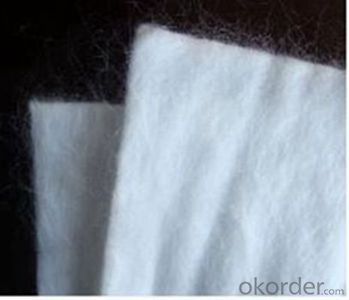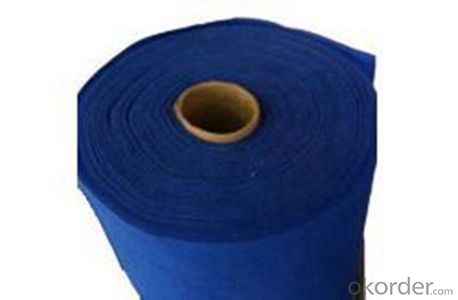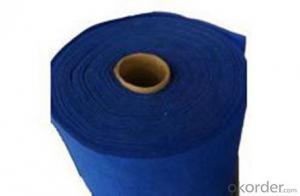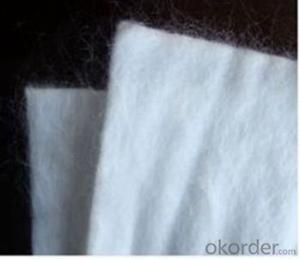PET&PP Short Fiber Needle Punched Geotextile For Drainage
- Loading Port:
- China main port
- Payment Terms:
- TT OR LC
- Min Order Qty:
- 3000 m²
- Supply Capability:
- 1000000 m²/month
OKorder Service Pledge
OKorder Financial Service
You Might Also Like
Item specifice
Density | Thickness | Breaking Strength | Elongation of Fracture | CBR Bursting Strength | Vertical Penetration Parameter | Equivalent Aperture |
g/m2 | mm | KN/m | % | KN | cm/s | O95 mm |
65 | 1.2 | 2.8 | 40 ~ 80 | 0.7 | K x (10-1 ~ 10-3) (K = 1.0 ~ 9.9) | 0.07 ~ 0.2 |
75 | 1.4 | 3.3 | 0.8 | |||
100 | 1.6 | 5.0 | 0.95 | |||
150 | 1.52 | 7.5 | 1.5 | |||
160 | 2.0 | 8.5 | 1.60 | |||
200 | 2.4 | 11 | 2.10 | |||
250 | 2.8 | 14 | 2.60 | |||
300 | 3.4 | 16 | 3.20 | |||
400 | 4.0 | 21 | 4.0 | |||
500 | 4.5 | 25 | 4.8 |


Packaging & Shipping
Packing: PLASTIC FILM INSIDE, AND WOVEN BAG OUTSIDE
Shipping: About 15 days after receipt the deposit
pecifications
geotextile fabric
permeability,filtration,easy for construction
ISO and CE certificate
Good quality and competitive price
Our Service
Quality assurance
1.On a regular basis or as per your request,we entrust national testing agencies to conduct quality inspections
2. Strictly in accordance with the ISO9001-2008 international quality system standard,we monitor and manage the whole process throughout production,quality testing,and measurement to ensure product quality
3. For quality-related construction delay or substandard construction(except for damage or losses due to customer’s responsibility or irresistible natural disasters),we have refunding,replacement,and repair services.We will respond to customers’ feedbacks on quality issues within 24 hours.
After-sales service
1.In order to provide customers with comprehensive technical support,we will provide technical and other related information upon request in a timely manner.
2.In required,we will appoint specialized technicians to the construction site to give technical trainings to construction people,and offer technical guidance throughout the whole construction process.
3.For damage due to shipment and delivery,after we receive the complaint,we will check the issure through provided pictures and videos.If our responsibility is confirmed,we wil offer free replacement.
4.When the construction is completed,as your request,our technical staff may participate in the final acceptance.
FAQ:
Q: What kind of payments does jenor support?
A: T/T, L/C, Cash are accepted.
Q: Do you charge for the samples?
A: Accordeing to our company policy, the samples are free, we only charge the freight fee. And we will return the freight fee during the next order.
Q: Can you produce according to customers' design?
A: Sure, we are professional manufacturer, OEM and ODM are both welcome.
Q: Do you have other products?
A: Yes, please check the pictures:
- Q:Are geotextiles suitable for use in erosion control blankets?
- Yes, geotextiles are suitable for use in erosion control blankets. They are designed to provide soil stabilization and erosion control by allowing water to pass through while retaining soil particles. Geotextiles help prevent soil erosion, promote vegetation growth, and enhance the overall effectiveness of erosion control blankets.
- Q:How are geotextiles tested for quality assurance?
- Geotextiles are tested for quality assurance through a series of standardized tests that evaluate their physical, mechanical, and hydraulic properties. These tests may include assessing tensile strength, elongation, puncture resistance, water permeability, and filtration efficiency, among others. By conducting these tests, manufacturers can ensure that geotextiles meet the required performance specifications and provide consistent quality for various civil engineering applications.
- Q:Are geotextiles suitable for use in drainage ditches?
- Yes, geotextiles are suitable for use in drainage ditches. Geotextiles can be used as a filtration and separation layer in drainage systems to prevent soil erosion and clogging while allowing water to flow through. They help improve the overall performance and longevity of drainage ditches by enhancing their filtration and drainage capabilities.
- Q:Can geotextiles be used in riverbank stabilization projects?
- Yes, geotextiles can be used in riverbank stabilization projects. Geotextiles are often employed to reinforce and protect soil in various civil engineering applications, including riverbank stabilization. They can help prevent erosion, control sediment movement, and provide stability to riverbanks by improving soil strength and drainage.
- Q:How do geotextiles contribute to environmental sustainability?
- Geotextiles contribute to environmental sustainability by preventing soil erosion, improving water quality, promoting vegetation growth, and reducing the need for harmful chemicals and excessive water usage in agriculture.
- Q:How do geotextiles affect soil erosion rates?
- Geotextiles can significantly reduce soil erosion rates by acting as a barrier against erosive forces such as water flow or wind. They provide stabilization and reinforcement to the soil, preventing it from being easily displaced or washed away. By enhancing the soil's resistance to erosion and promoting vegetation growth, geotextiles help maintain soil integrity and reduce erosion rates.
- Q:Precautions for Polyester Filament Geotextiles
- 1. Geotextiles can only be cut with a geotextile (hook knife), such as in the field of cutting, other materials to take special protective measures to prevent the cutting of geotextiles and its unnecessary damage; Laying geotextile at the same time, must take all necessary measures to prevent damage to the following layer of material; 3. In the laying of geotextiles, we must pay attention not to let the stone, a lot of dust or moisture may damage the geotextile, Drains or filters, or materials that may cause difficulties for subsequent connections to enter beneath geotextiles or geotextiles; 4. After installation, visualize all geotextile surfaces to identify all damaged landlords Marking and repairing, to determine the laying of the surface can not cause damage to foreign substances, such as broken needle and other foreign body; 5. Geotextile connection must follow the following provisions: Under normal circumstances, the slope can not have a horizontal connection (connection along the slope The contours do not intersect with them), except where the patch is located. 6. If the use of suture, suture should be used with geotextile material the same or more than the material, suture should be anti-chemical UV material holding. Suture and geotextile should have a significant color difference in order to facilitate inspection. 7. Special attention to suturing during installation to ensure that no gravel in the soil or gravel cover is in the middle of the geotextile.
- Q:What is the role of permeability in geotextiles?
- The role of permeability in geotextiles is to allow the passage of water or other fluids while restraining the movement of soil particles. It helps in drainage and filtration processes, preventing the buildup of excess moisture and maintaining the stability and integrity of the surrounding soil or substrate.
- Q:Geotextile and blind tube is how the drainage ah?
- After the blind tube is easy to plug, and geotextile water permeable, the combination of the two, so that the drainage effect is better. Hope to help you.
- Q:What are the specifications for geotextiles in subsurface drainage projects?
- The specifications for geotextiles in subsurface drainage projects typically include factors such as the material type, weight, thickness, and permeability. These specifications ensure that the geotextile is capable of effectively filtering water and preventing soil particles from clogging the drainage system. Additionally, the specifications may outline requirements for strength, durability, and UV resistance to ensure the geotextile can withstand the environmental conditions in the subsurface drainage projects.
1. Manufacturer Overview |
|
|---|---|
| Location | |
| Year Established | |
| Annual Output Value | |
| Main Markets | |
| Company Certifications | |
2. Manufacturer Certificates |
|
|---|---|
| a) Certification Name | |
| Range | |
| Reference | |
| Validity Period | |
3. Manufacturer Capability |
|
|---|---|
| a)Trade Capacity | |
| Nearest Port | |
| Export Percentage | |
| No.of Employees in Trade Department | |
| Language Spoken: | |
| b)Factory Information | |
| Factory Size: | |
| No. of Production Lines | |
| Contract Manufacturing | |
| Product Price Range | |
Send your message to us
PET&PP Short Fiber Needle Punched Geotextile For Drainage
- Loading Port:
- China main port
- Payment Terms:
- TT OR LC
- Min Order Qty:
- 3000 m²
- Supply Capability:
- 1000000 m²/month
OKorder Service Pledge
OKorder Financial Service
Similar products
New products
Hot products
Related keywords































